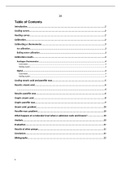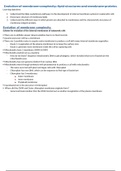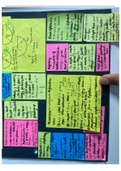Table of Contents
Introduction.................................................................................................................................................. 2
Axial skeleton............................................................................................................................................... 2
Appendicular skeleton.................................................................................................................................. 7
Bone types.................................................................................................................................................. 14
Bone composition....................................................................................................................................... 16
Periosteum.........................................................................................................................................................16
Spongy bone......................................................................................................................................................16
Compact bone....................................................................................................................................................17
Bone marrow.....................................................................................................................................................17
Mineral use........................................................................................................................................................18
Joint types.................................................................................................................................................. 18
Classification of joints................................................................................................................................. 20
Ligaments................................................................................................................................................... 21
Tendons...................................................................................................................................................... 22
Muscle........................................................................................................................................................ 22
Major muscle groups.........................................................................................................................................22
Skeletal functions........................................................................................................................................ 26
Movements................................................................................................................................................ 29
Arthritis...................................................................................................................................................... 31
Joint hypermobility syndrome..................................................................................................................... 34
Hip dysplasia............................................................................................................................................... 35
Case study – hip dysplasia........................................................................................................................... 38
Conclusion.................................................................................................................................................. 39
Bibliography............................................................................................................................................... 39
1
,Introduction
In this report I will be looking at the musculoskeletal system. The composition of
the skeleton will be looked at in depth to understand the function and why it is
necessary for the musculoskeletal system. The musculoskeletal system gives
shape, stability, and mobility to the human body. The bones of the body,
muscles, tendons, ligaments, joints, cartilage, and other connective tissue make
up the connective tissue (which make up the skeleton). The
term "connective tissue" is used to describe the tissue that https://bit.ly/3JAAZpI
protects and connects tissues and organs. Its main
components are collagen and elastic fibres, which are made
up of different proteins.
Axial skeleton
The skull, ossicles of the middle ear, hyoid bone of the throat,
vertebral column, and thoracic cage make up the axial
skeleton (as seen in figure 1), which runs through the centre
of the body. The brain, spinal cord, and organs in the ventral
body cavity are all supported and protected by the axial
skeleton. It offers a surface for muscles that move the head,
neck, and trunk, perform
respiratory motions, Figure 1 is and stabilise
sections of the showing us the appendicular skeleton to adhere
to. composition of
the axial
Feature Structure Function
Skull
The cranium is a The cranium's primary
spherical-shaped role is to protect the
structure that links to brain while also
the facial bones at the providing a surface for
top of the head. The the facial muscles to
cranial roof and cranial connect. There is no
base are the two movement or action
primary components of involved with the
the cranium. Frontal, cranium. The cranial
occipital, and two nerves start inside the
parietal bones form the skull and escape
cranial roof. The frontal, through cranial bone
sphenoid, ethmoid, channels. These nerves
https://bit.ly/3tDPIuD
occipital, parietal, and are required for daily
Cranium temporal bones are the activities such as
bones that make up the smelling, seeing, and
cranial base. To keep hearing.
your brain safe and
sound, the skull bones
are fused together.
2
, Mandible The mandible is the The mandible is an
largest facial bone that important structural
defines the face's lower and protective
borders and sides. The component of the body.
body and the ramus are Not only do vital nerves
the two major and muscles pass into
components of it. The and emerge from this
mandible's body is bone, but it also
the rectangular front contains the bottom set
(anterior) section of the of teeth.
bone, which is attached
https://bit.ly/3Le8771 to each side's ramus
(wing-like segment).
Maxilla The maxilla is the The maxilla is used for
centre of the face, and a variety of purposes. It
it is placed in the defines the face and
middle of the skull. The gives vital bone
alveolar process structure to the skull.
connects the bottom The maxilla is important
section of the maxilla for chewing and
with the upper teeth. speaking since it
The teeth's roots create contains the upper
grooves that run the teeth and is a part of
length of the maxilla's the jaw. The mucous
anterior part. The membrane that lines
frontal process refers to the maxillary sinuses
the part of the maxilla warms and humidifies
that articulates the air we breathe, as
superiorly with the well as producing
frontal bone and mucus, which serves as
medially with the nasal an immune
https://bit.ly/3ixZsQE bones. The nasolacrimal defence. The maxilla is
groove, the lower responsible for forming
centre of the forehead, the nasal cavity's floor
and the nasal bridge and lateral walls, as
are all key structures well as breathing,
formed by the frontal humidification etc.
process.
Vertebral column
Cervical vertebrae Two physically and The cervical spine
functionally distinct connects the head to
segments make up the the comparatively
cervical spine. Rotation, immobile thoracic
lateral flexion, flexion, spine, providing it with
and extension of the mobility and stability.
head and neck are all Nodding the head is
produced by these two primarily accomplished
segments working via flexion and
together. The cervical extension of the
spine is significantly atlanto-occipital joint,
more movable than the which connects the
thoracic or lumbar atlas with the occipital
spine. Transverse bone. The atlanto-axial
foramina in each joint, which connects
3
, vertebra for the the atlas and the axis,
vertebral arteries that is almost entirely
supply blood to the responsible for moving
brain distinguish the the head left and right.
cervical spine from the The movement is aided
rest of the spine. by a modest degree of
rotation of the spinal
column.
Thoracic vertebrae Between the cervical The purpose of the
and lumbar vertebrae thoracic vertebrae is to
are the thoracic support the back. They
vertebrae. Humans create a protective
have 12 thoracic cage around the
vertebrae, which grow sensitive organs of the
in size as they progress thorax, such as the
down the spine. They heart and lungs, thanks
are larger and thicker to their articulations
than the cervical with the ribs. It
vertebrae, but smaller safeguards the spinal
than the lumbar cord, which is a bundle
Figure 6: vertebrae. They can of nerves that connects
https://bit.ly/3wCUZEt now support the body's your brain to the rest of
weight because of their your body. It serves as
increased size. a point of connection
for your ribs and aids in
breathing assistance.
Lumbar vertebrae The lumbar vertebrae The purpose of the
are the bones of the lumbar vertebrae is to
lower back that make sustain the body's
up the spinal column or heavy weight while still
backbone. These bones allowing specific
are located just below actions, such as lifting
the cervical and objects. Rotation
thoracic vertebrae, but between the vertebrae
above the sacrum or and sagittal plane
pelvis. They are the movements allow the
largest unfused lumbar vertebrae to
vertebrae, and they are flex and extend. The
bigger than the bones spinal cord and nerves
above them. The are protected by these
lumbar vertebrae are bones, which also offer
made up of five bones. support. The biggest
Figure 7: The thoracic vertebrae vertebral bones are the
https://bit.ly/3wyBPQh are located close to lumbar vertebrae. To
these in humans. The sustain the body's
lower back curves growing weight, they
concavely as a result of grow in size as it moves
these bones. down the spine.
4











